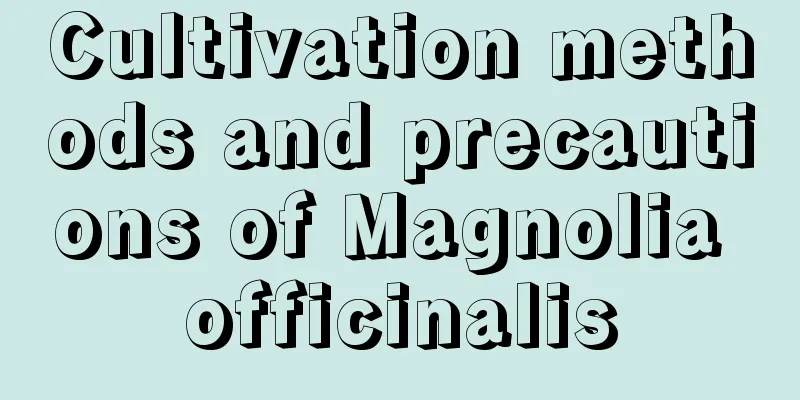Cultivation methods and precautions of Magnolia officinalis

1. Maintenance methods1. Temperature: Magnolia officinalis is a plant that likes cool weather. Generally speaking, in areas where it is suitable for distribution, the average annual temperature is generally between fourteen and twenty degrees. During the coldest time, the average temperature should reach between three and nine degrees so that it can survive the winter safely. 2. Light: Magnolia officinalis is light-loving. During its growth period, it has high requirements for sunlight, otherwise its growth will be very slow and it is easy to grow too tall. Therefore, during this period, do not be too shaded. When encountering very strong light, you can provide some shade, but do not block out the light completely. 3. Watering: Magnolia officinalis likes moisture and has very high requirements for air humidity. And because its root system is relatively developed, it has good waterlogging resistance. During the growth period, water needs to be replenished in time to ensure moisture. But in winter, especially when the temperature is very low, you have to control the water. 4. Fertilization: It has a certain demand for fertilizer, but not too much. In addition to the fixed base fertilizer, the number of topdressing applications can be controlled to twice a year, and there is no need to do it too much. 2. Breeding techniques1. Reproduction: It can be propagated by sowing. From September to October, you can prepare to collect fruits and obtain seeds. After harvesting, store it in moist sand. In the spring of the second year, it can be taken out and sown. Because there is a waxy layer on its surface that prevents it from germinating, it needs to be removed before sowing. The "row sowing" method can be adopted, the row spacing can be about 30 cm, and the distance between each seed can be between 3 and 6 cm. 2. Weeding: This step is more important because there will be many weeds every once in a while. Generally speaking, weeding should be done at least twice a year. After weeding, top dressing can be carried out. 3. Problem diagnosis and treatment1. Disease: The main type is "leaf blight", which can be controlled by Bordeaux. There will also be "damping-off disease". In addition to spraying pesticides, the substrate must also be disinfected, for example, with lime. 2. Pests: Mainly "brown longhorn beetles", the adult of which is more harmful, so the main task is to catch and kill its adults. IV. Other issues1. Toxicity: It is not poisonous. Moreover, it is a good medicinal material. 2. Can it be raised at home? Generally not. Firstly, it is relatively large in size and is not suitable for home. Also, it is also a protected plant. |
<<: The cultivation methods and precautions of Red Prince Weigela
>>: Cultivation methods and precautions of flower peony
Recommend
Will the green radish grown in water freeze to death in winter? Can it be exposed to the sun in winter?
1. Will I freeze to death? Whether the water-grow...
Why do dragon beard trees have drooping leaves?
1. Reasons 1. If you give too much water during d...
Can I grow honeysuckle trees at home?
Can I grow honeysuckle trees at home? You can pla...
What is leek?
What is leek? Chinese chives are a plant of the g...
What are the functions of daffodils?
The ornamental value of daffodils Daffodils have ...
You can buy a pot of colorful peppers for 4 yuan, and 100 fruits will pop out. You can make hot sauce with it to eat 3 bowls of rice!
4 little tricks to make colorful peppers bear fru...
How to water Hawaiian coconut palms
Hawaiian Coconut Watering Tips Hawaiian coconut r...
Cultivation methods and precautions of Clematis
1. Watering The plant Clematis has relatively hig...
What is the best soil for juniper bonsai?
Juniper bonsai likes loose, breathable, deep, hum...
The correct way to fertilize bone meal
Many people like to grow flowers and plants at ho...
How to propagate camellia and how to reproduce offspring
1. Cutting propagation Cuttings should be taken i...
Can wolfberry trees be transplanted in winter? Can transplanted wolfberry trees survive?
Can wolfberry trees be transplanted in winter? Wo...
Change the "method" of growing spider plants, and the roots will grow faster and the "green leaves" will keep popping up!
When we grow spider plants at home, we usually us...
How to raise a magic wand
1. Adequate lighting The magic wand flower likes ...
Top 10 indoor flowers rankings The best flowers and plants to grow indoors at home
Indoor flowers refer to plants that can be grown ...









